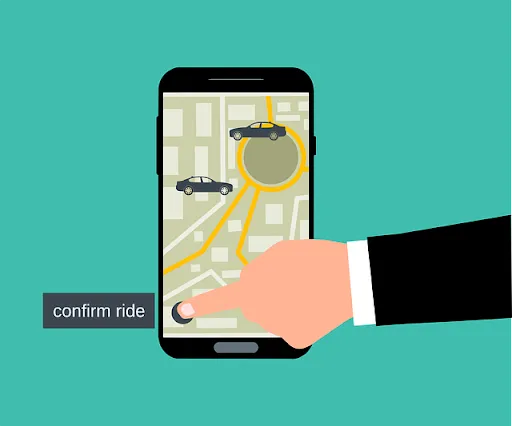For centuries, urban transportation largely revolved around horse-drawn carriages, rickshaws, and, with the dawn of the 20th century, the iconic yellow taxis that came to symbolize city life in metropolises from New York to Mumbai. These traditional modes, whether hailed from a street corner or called upon via dispatchers, played a primary role in shaping how individuals moved within cities. As the 21st century unfolded, a revolutionary idea began to disrupt this age-old system: ridesharing. Leveraging the ubiquity of smartphones and advancements in digital platforms, the rideshare concept introduced a more decentralized, app-driven approach to urban transportation.
This article explains the meteoric rise of rideshare apps and how they’ve transformed urban mobility. This article studies the impacts platforms like Uber and Lyft have on cities, society, and the very fabric of transportation. Rideshare apps, while presenting their own set of challenges, have ushered in a transformative era of flexibility, innovation, and accessibility in urban transport.
Table of Contents
Timeline of Rideshare Evolution
Before the digital revolution transformed commuting, taxis and other localized transportation services were the lifeline of urban mobility, bridging gaps and shuttling residents and visitors alike. It wasn’t uncommon for a driver to seek the assistance of a traffic ticket lawyer, especially in bustling cities where keeping track of traffic rules could be a challenge. These modes, though functional, largely relied on manual dispatch systems and spontaneous street hails. As the digital wave intensified, a paradigm shift emerged with the entry of rideshare behemoths like Uber and Lyft in the late 2000s and early 2010s. Their app-centric, on-demand approach was not just disruptive; it redefined how people perceived and accessed transportation. As their success reverberated worldwide, it catalyzed the birth of regional heavyweights — Grab in Southeast Asia, Ola in India, and Didi in China — each adapting and innovating within their unique cultural and logistical approaches, marking a global renaissance in the way we move.
Key Factors Driving Rideshare Popularity
1. Convenience
Easy Booking Through Apps
The digital age ushered in the convenience of hailing a ride from anywhere, anytime, with just a few taps on a smartphone, eliminating the traditional wait and uncertainty of hailing a taxi.
Door-to-Door Service and Route Flexibility
Rideshares offer personalized transportation, picking up riders from their exact location and dropping them off right at their destination, providing a seamless travel experience tailored to individual needs.
2. Cost-Effectiveness
Competitive Pricing Compared to Traditional Taxis
Many riders have found ridesharing to be a more affordable option than traditional taxis, especially during non-peak hours.
Dynamic Pricing and Multiple Ride Options
With the introduction of dynamic pricing, riders can choose from a range of options, from shared rides to luxury vehicles, fitting different budgets and preferences.
3. Economic Opportunities
Job Creation for Drivers
Rideshare platforms have undeniably provided employment opportunities. For instance, as of 2019, Uber reported having over 3 million active drivers globally, and Uber is only one of many rideshare apps that the market has to offer, emphasizing the opportunities this franchise offers.
Ancillary Business Opportunities
Beyond direct employment, ridesharing has spurred growth in related industries such as car maintenance, cleaning services, and accessories tailored for rideshare vehicles.
4. Technological Innovations
Advanced GPS Tracking
Modern rideshares rely heavily on precise GPS technology, ensuring accurate pickups, drop-offs, and optimal route selection, enhancing user experience.
Integration with Other Services
Many rideshare companies have diversified, offering additional services like food delivery, thereby consolidating their presence in users’ daily lives.
5. Changing Societal Values
Shift Towards Shared Economy
As the world becomes more interconnected, there’s a growing preference for shared resources, and ridesharing fits perfectly into this new societal mold.
Reducing Carbon Footprint with Ridesharing
Environmentally conscious individuals opt for rideshares, especially pooled options, as a step towards reducing the number of vehicles on the road and subsequently, the carbon footprint.
Impacts on Urban Mobility and Infrastructure
1. Reduction in Private Car Ownership
As ridesharing gains traction, many urban dwellers are reconsidering the necessity of owning a car. The convenience and affordability of hailing a ride on-demand often outweigh the costs and responsibilities of car ownership.
2. Challenges to Public Transportation
Some cities witness a decline in public transportation ridership, raising concerns about sustainability and public investment.
3. Impact on Traffic Congestion and Parking Demand
The influx of rideshare vehicles has led to debates about their contribution to city traffic. With fewer individuals opting for personal cars, urban areas may see a decreased demand for long-term parking spaces, potentially freeing up space for other infrastructural developments.
4. Potential for Promoting Carpooling and Environmental Sustainability
Rideshare platforms, by introducing carpooling options, encourage riders to share trips with others headed in the same direction. This not only reduces the number of vehicles on the road but also promotes a culture of shared resources, leading to potential environmental benefits.
The Future of Ridesharing
The advent of autonomous vehicles hints at a not-so-distant future where driverless rideshares streamline city commutes, promising enhanced safety and efficiency. As sustainability takes center stage, integration with eco-friendly transportation methods, like e-scooters and bikes, is becoming increasingly prevalent, offering diverse mobility solutions within a unified digital ecosystem. On the business frontier, evolving models such as subscription-based ridesharing and strategic corporate partnerships indicate a shift towards more personalized and consistent user experiences. As rideshares continue to innovate, they hold immense potential to complement and bridge gaps in existing public transport infrastructures, knitting together a comprehensive and accessible transit network for all.
Ridesharing, once a fledgling idea, has irrevocably altered urban mobility, offering a blend of convenience, innovation, and adaptability. As the industry continues to develop, addressing challenges and seizing opportunities, it highlights the transformative power of technology and shared economies in reshaping our daily lives. Synthesizing progress and tradition, rideshare apps stand as a testament to humanity’s quest for better, smarter, and more sustainable ways to connect and commute.



